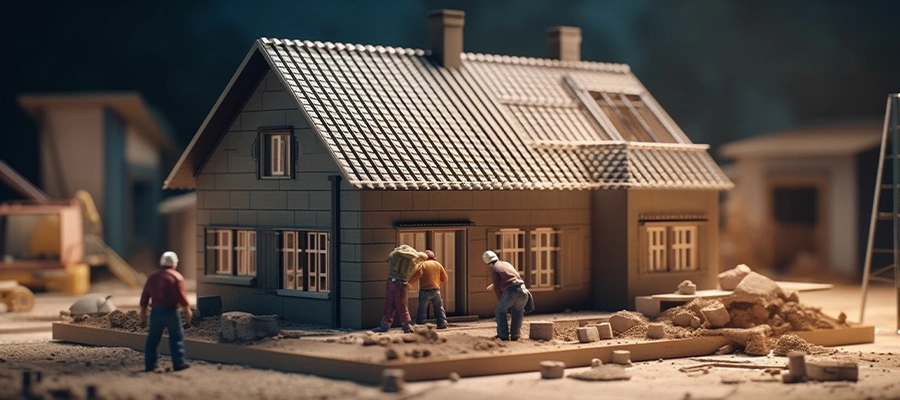Though creating your ideal home is exciting, have you ever considered the silent hero that lies beneath it all: your home’s foundation? To ensure your aspirations are grounded in reality, let’s get down figuratively as we investigate the realm of home foundations. Numerous foundation kinds and variables might affect the final cost and layout.
Ever heard the phrase “Constructed upon a strong foundation”? It is the actual framework of your house, not simply a metaphor. The sort of foundation you select can determine the stability and lifespan of your home.
Brick & Bolt explains the foundations for building a house in this blog. So, let’s set off on this path of foundational work together.
Types of Foundations in Construction
There are various foundations that you may become familiar with.
Examining Strip Foundations: An Examination of the Fundamentals
The strip foundation might be compared to a trustworthy buddy who is always there for you. It equally distributes the weight so that your house doesn’t settle favouritism. For good reason. Who wouldn’t want a trustworthy foundation partner? Many turn to it.
Pier Foundations: Overcoming Obstacles
If your house were a ship, the pier foundations would be the dependable docks to keep it afloat. Piers are useful for difficult terrain and water tables because they offer support and stability.
A Comprehensive Guide to a Strong Foundation
1. Excavation: Digging the Unidentified

Digging is the main priority. It resembles getting the canvas ready for a painting. I missed this stage when building my second house because I assumed it was digging. I had yet to learn that a thorough excavation would guarantee that your foundation fits well.
2. Formwork and Strengthening: Constructing the Bone Structure
Has a structure ever been seen without a skeleton? Reinforcing and formwork have a similar effect on your foundation. It’s similar to giving your house a spine, which is essential for stability and strength.
3. Pouring Concrete: The Lifeblood of Your House
Your home’s heart begins to beat the moment you pour concrete. Nerves and excitement are mixed. Like baking, a strong foundation cake is ensured using the correct elements (in this case, the mix and consistency).
Selecting the Proper Components: Building Materials for Foundations
Concrete: The Unwavering Foundation
Concrete is the superman of foundation materials. It is a popular option among homeowners because it is strong and long-lasting. My recommendation? Make sure to pay attention to the quality of the concrete. It’s the superhero your house is meant to have.
Steel Reinforcement: Developing a Sturdy Structure
Have you ever observed a steel web inside your foundation? That’s reinforcement at play. It functions similarly to armour, shielding your house against pressure and the passage of time.
Foundation Fears: Dispelling Myths for a Calm Construction
The fallacy is that “Every foundation is the same.”
Dealing with the Settling Fear: “My House Will Sink”
Although it’s a prevalent concern, settling becomes a controllable part of your home’s journey with the right foundation type and proper design. Don’t let your fear of falling behind keep you back.
How to Choose the Right Foundation?

Being a homeowner involves making decisions about your foundation, or at least knowing what factors the builder considers when making a foundation choice, even though it can be more enjoyable than choosing floor plans or colour schemes. Here are some factors that determine the best foundation for each home.
Lot and Environment Specifications
The lot and its surroundings should be taken into account first. This can comprise, but is not restricted to:
- What is the lot’s grade? In other words, is your lot sloped? Because the stem walls, which close into the crawlspace, can be different heights, crawlspaces are common on sloped properties.
- What kind of climate will it be where your home is built? Although concrete slabs are ideal in southern climes, they may shift and crack in colder regions due to frequent freezing and thawing of the earth. In colder climates, consider using a basement foundation for your construction.
- What kind of soil does your land have? Stable, level ground that won’t shift is generally necessary for foundations, especially concrete slabs.
- However, this could be difficult if you’re building a coastal house. In this case, you would be better off with a pier foundation.
- What levels of water are there? The water table, also known as the point at which the ground becomes saturated, is where footings and foundations should be placed. The depth at which certain foundations, like basements, must be built can influence the choice of foundation, regardless of how high or low the water table is.
Styles and Designs of the Home
Certain home styles are better suited for certain foundations. For example, sprawling constructions are not advised for pier foundations because they can cause floors to sag between piers.
Foundation Goals
Consider the potential uses for your foundation. Different foundations have different applications. Completed basements are popular because they increase the amount of usable square footage in a house and can be equipped with guest rooms, lounge areas, and other amenities.
Conversely, crawlspaces provide a place to store things, but because of their short stem walls, they cannot be used as a room. Although concrete slabs don’t add any extra room, many homeowners find them an excellent option because of their other advantages.
Selecting the right foundation for your house is similar to choosing the ideal dance partner. It guarantees seamless, elegant travel and supports all of your movements. Thus, prospective homeowners, think about your choices, take advice from other’s experiences, including mine, and may your house rise tall on a foundation as solid as your aspirations.

